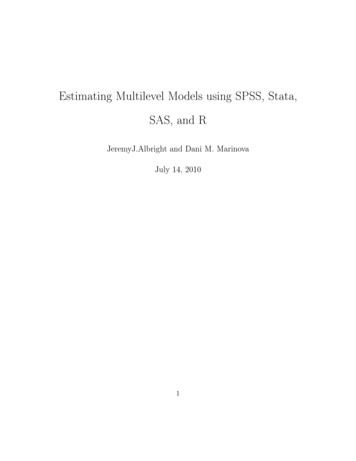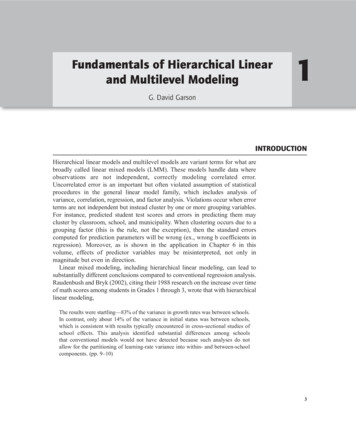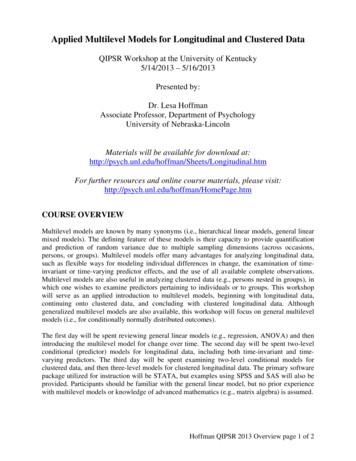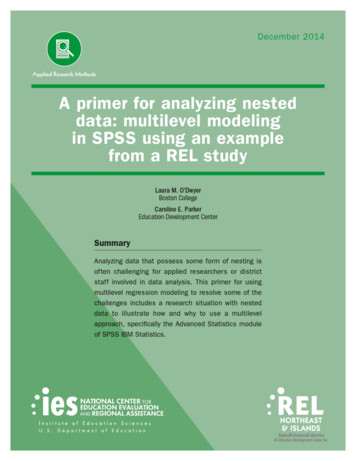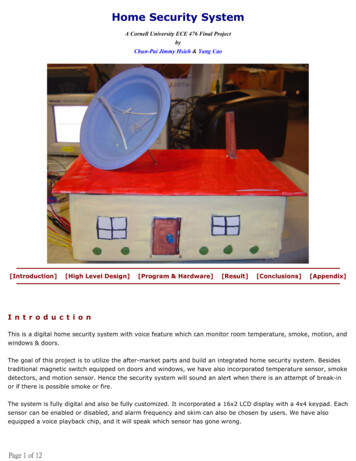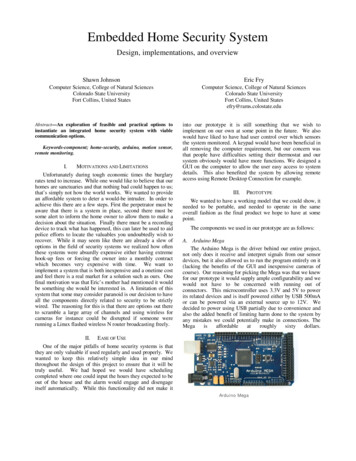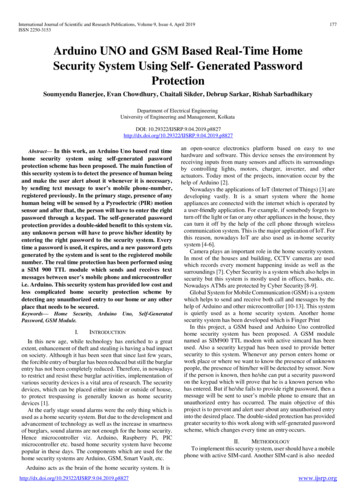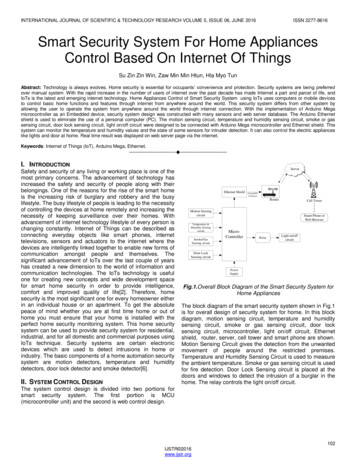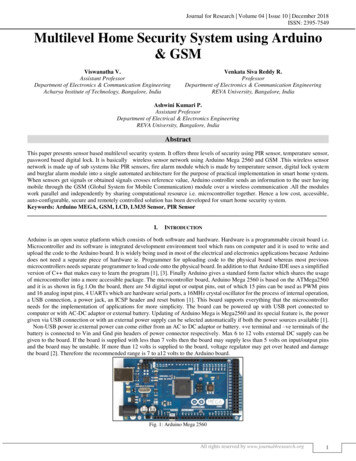
Transcription
Journal for Research Volume 04 Issue 10 December 2018ISSN: 2395-7549Multilevel Home Security System using Arduino& GSMViswanatha V.Assistant ProfessorDepartment of Electronics & Communication EngineeringAcharya Institute of Technology, Bangalore, IndiaVenkata Siva Reddy R.ProfessorDepartment of Electronics & Communication EngineeringREVA University, Bangalore, IndiaAshwini Kumari P.Assistant ProfessorDepartment of Electrical & Electronics EngineeringREVA University, Bangalore, IndiaAbstractThis paper presents sensor based multilevel security system. It offers three levels of security using PIR sensor, temperature sensor,password based digital lock. It is basically wireless sensor network using Arduino Mega 2560 and GSM .This wireless sensornetwork is made up of sub systems like PIR sensors, fire alarm module which is made by temperature sensor, digital lock systemand burglar alarm module into a single automated architecture for the purpose of practical implementation in smart home system.When sensors get signals or obtained signals crosses reference value, Arduino controller sends an information to the user havingmobile through the GSM (Global System for Mobile Communication) module over a wireless communication .All the moduleswork parallel and independently by sharing computational resource i.e. microcontroller together. Hence a low cost, accessible,auto-configurable, secure and remotely controlled solution has been developed for smart home security system.Keywords: Arduino MEGA, GSM, LCD, LM35 Sensor, PIR SensorI.INTRODUCTIONArduino is an open source platform which consists of both software and hardware. Hardware is a programmable circuit board i.e.Microcontroller and its software is integrated development environment tool which runs on computer and it is used to write andupload the code to the Arduino board. It is widely being used in most of the electrical and electronics applications because Arduinodoes not need a separate piece of hardware ie. Programmer for uploading code to the physical board whereas most previousmicrocontrollers needs separate programmer to load code onto the physical board. In addition to that Arduino IDE uses a simplifiedversion of C that makes easy to learn the program [1], [3]. Finally Arduino gives a standard form factor which shares the usageof microcontroller into a more accessible package. The microcontroller board, Arduino Mega 2560 is based on the ATMega2560and it is as shown in fig.1.On the board, there are 54 digital input or output pins, out of which 15 pins can be used as PWM pinsand 16 analog input pins, 4 UARTs which are hardware serial ports, a 16MHz crystal oscillator for the process of internal operation,a USB connection, a power jack, an ICSP header and reset button [1]. This board supports everything that the microcontrollerneeds for the implementation of applications for more simplicity. The board can be powered up with USB port connected tocomputer or with AC-DC adaptor or external battery. Updating of Arduino Mega is Mega2560 and its special feature is, the powergiven via USB connection or with an external power supply can be selected automatically if both the power sources available [1].Non-USB power ie.external power can come either from an AC to DC adaptor or battery. ve terminal and –ve terminals of thebattery is connected to Vin and Gnd pin headers of power connector respectively. Max 6 to 12 volts external DC supply can begiven to the board. If the board is supplied with less than 7 volts then the board may supply less than 5 volts on input/output pinsand the board may be unstable. If more than 12 volts is supplied to the board, voltage regulator may get over heated and damagethe board [2]. Therefore the recommended range is 7 to a12 volts to the Arduino board.Fig. 1: Arduino Mega 2560All rights reserved by www.journal4research.org1
Multilevel Home Security System using Arduino & GSM(J4R/ Volume 04 / Issue 10 / 001)Security SystemWireless security is the prevention of unauthorized access or damage using wireless networks as a systematic solution for homesecurity. Wireless technologies like Bluetooth. Infrared, Wi-Fi and GSM are available to access the system for security andautomation [3], [6]. Now days everybody wants to take care to prevent intrusion because crime is increasing day by day. Theproposed system characteristics involve remote control of appliances, system security and intrusion control using GSM basedwireless technology.Block DiagramThe block diagram of the security system is as shown in fig.2 and it consists mainly of the blocks as follows, Source Sensing block Decision making block Alert systemFig. 2: Block Diagram of Security System SourcePower to the Arduino microcontroller is supplied through a 12 V, 1 ampere adapter. Sensing CircuitTemperature sensor: LM35 is employed to monitor ambient temperature conditions in the premises. The LM35 is better compareto linear temperature sensor which is standardized in Kelvin, since a large constant voltage is subtracted from the output to getconvenient centigrade scaling which is done by device itself [4],[6]. No user is required to do this. The LM35 is easily interfacedto readout or control circuitry because of its special characteristics of low-output impedance, linear output and precise inherentcalibration. KeypadIn matrix keypads, four columns and four rows combination is use to determine the state of the button to the microcontroller orany other host device. Pushbutton is used in each key, one end is connected to one row and the other end is connected to onecolumn [4]. Based on the state of columns, microcontroller can understand which button is pressed. Decision Making BlockHere, Arduino mega microcontroller board is used which decides the appropriate action to be taken as and when required. TheArduino Mega can be powered via the USB connection or with an external power supply.The power source is selected automatically. External (non-USB) power can come either from an AC-to-DC adapter or battery[5]. Leads from a battery can be inserted in the Gnd and Vin pin headers of the POWER connector. Alert SystemIn the hardware Implementation, alert system consists of buzzer which produces audio signal and this device can be mechanical,piezoelectric or electromechanical system [3]. Typically it is used in alarm, timers and confirmation of user inputs such as mouseclick or keystroke GSM ModuleExtension of GPRS is GSM that supports higher data transmission rate .Basically GSM module is used to setup a communicationbetween the host and GSM module. In this implementation, host is mobile device and any data comes from microcontroller is sentto user through the GSM module over wireless communication [3].All rights reserved by www.journal4research.org2
Multilevel Home Security System using Arduino & GSM(J4R/ Volume 04 / Issue 10 / 001)II. WORKING PRINCIPLEFig. 3: Block Diagram Depicting the Working of Security SystemThree level home security systems are depicted in terms of blocks as shown in fig.3 and is explained as follows.1) Connect a 12V, 1A adapter to GSM module after inserting the SIM card and then wait for the network initialization.2) Connect USB cable to Mega 2560 with laptop or connect one more adapter to Mega 2560 DC pin to supply the power.3) As soon as we press the password set push button, the LCD will start to display.4) When display shows “SET 5 digit password”, enter 5 digit password which will be shown on the LCD display. Set thepassword and lock it.5) Enter the correct password then press “A” to unlock. Only if the password is correct, motor will rotate and door will open.6) Two PIR sensors are used for two separate rooms and one PIR sensor is located in each room.7) If any intrusion is sensed in any room then the buzzer attached to the PIR sensor starts alarm and simultaneously the cameramotor will also rotate to track the motion so that the viewer can see the live recording.8) PIR sensors can be tested by creating an obstruction in front of any PIR sensor, the buzzer will beep and camera motor willrotate.9) Then, check with wrong password. If password is incorrect, then the motor controlling door will not rotate and simultaneouslythe message is sent to the owner and also when someone try to change the password, the message will be sent to the owner.10) After the user enters the premises by entering the correct pass key and needs to reactivate the system while leaving, “B” key isto be pressed.11) If the owner wants to change the password then enter the present correct password and press “C” key. Enter the new passwordto set the new password.12) The temperature sensor, LM3 senses the temperature when it exceeds the set ambient temperature of the premises. A message“temperature is not normal in the room”, is sent by the GSM module alerting the owner of the same.Table – 1The Entire Methodology is summarized in Table 1If, Password is incorrectTemperature rises beyond limitIntrusion is detectedThen,These outputs will be fedinto the ArduinoArduino with the help of GSMmodule and a SIM card will send amessage accordinglyThe owner of the registerednumber will receive themessageIII. SOFTWARE & PROGRAMSoftwareThe Arduino Mega2560 is capable of communicating with other Arduino, computer or other microcontrollers. The ATmega2560affords hardware UARTs of numbers four for serial communication (TTL)[1].On board ATmega8U2 channels, one of them overUSB offers virtual communication port to software on the computer ( OS window needs a .in file, but OSX and Linux OS recognizethe board as a COM port robotically) [1],[2]. The Arduino tool has a serial monitor which allows simple data to be sent to andfrom the Arduino board. The RX and TX LEDs on the Arduino board get flash when data is being transmitted via the ATmega8U2chip and USB connection to the computer (but not on pins 0 and 1 for serial communication) [2],[3]. A serial library permits forserial communication on any of the Mega's digital pins.All rights reserved by www.journal4research.org3
Multilevel Home Security System using Arduino & GSM(J4R/ Volume 04 / Issue 10 / 001)ProgramLogic of the program used for the implementation of hardware using Arduino controller is depicted in terms of flowchart shownin fig.4Fig. 4: Flowchart of Three Levels of Home Security SystemIV. HARDWARE IMPLEMENTATION1)2)3)4)5)6)7)Arduino Mega 2560Temperature sensorsH bridge motor driver circuitPassive Infrared SensorGlobal system for mobile communicationKeypadLiquid Crystal DisplayHardwareComplete hardware implementation is depicted in the fig.5Fig. 5: Complete Hardware of Arduino Based Security SystemAll rights reserved by www.journal4research.org4
Multilevel Home Security System using Arduino & GSM(J4R/ Volume 04 / Issue 10 / 001)V. RESULTSCase 1. When PIR Sensor Detects Intrusion, the Message given in fig.6 Sent to the OwnerFig. 6: Message Received by the OwnerCase .2 when Temperature Exceeds Ambient Limits, the Message given in fig.7 Sent to the OwnerFig. 7: Message Received by the OwnerCase. 3 When Change in Password is detected, the Message given in fig.8 sent to the OwnerFig.8 Message Received by the OwnerCase .4 When Correct Password is Entered, the Message Given in fig.9 Sent to the OwnerAll rights reserved by www.journal4research.org5
Multilevel Home Security System using Arduino & GSM(J4R/ Volume 04 / Issue 10 / 001)Fig. 9: Message Received by the OwnerVI. CONCLUSIONHome Security is a main concern worldwide. Since the technology is getting advanced, various home based security systems aredeveloped and implemented to protect our homes from illegal invasion. In this paper, multilevel home security (MHSS) which hasbeen designed and developed consists of motion sensor, temperature sensor, GSM module, LCD display and an alarm circuit.Alarm system is to alert the house owner and neighbors and also sends alert messages to the house owner.Hence to conclude the basic three levels of home security system, the use of Arduino Mega microcontroller lets us control manysubsystems and at the same time letting the use of single system. The system can be further developed using automatic gas breakingdetector/motion detector so the solution can be integrated with these and other security systems. In addition this system will beself-contained power supply system and not prone to electric li Javale,Assistant Professor,Dept. of Computer Engg ,MAEER's MITCOE Pune, India ;Mohd. Mohsin Student ,Dept. of Computer Engg,MAEER'sMITCOE ,Pune, India ;Shreerang Nandanwar ,Student ,Dept. of Computer Engg ;MAEER's MITCOE ,Pune, India ;Mayur Shingate Student ,Dept. ofComputer Engg ;MAEER's MITCOE ,Pune, India. (2013, March). Home Automation and Security System Using Android ADK. International Journal ofElectronics Communication and Computer Technology (IJECCT). [Online]. 3(2). Available:http://www.academia.edu/14501543/Home Automation and Security System Using Android ADK.Dinesh Suresh Bhadane Department of E&TC Sandip Polytechnic, Nashik, Maharashtra, India ;Monali D. Wani, Department of E&TC Sandip Polytechnic,Nashik,Maharashtra,India ;Sanjeev. A. Shukla, Department of E&TC SITRC, Nashik, Maharashtra, India.( 2015, February). A Review on Home ControlAutomation Using GSM and Bluetooth. International Journal of Advanced Research in Computer Science and Software ol-Automation-Using-GSM-and-Bluetooth.Bhargav B. Patel, Assistant Professor, E & C Department, GTU University, Gujarat, India ;Keyur Chauhan, Assistant Professor, E & C Department, GTUUniversity, Gujarat, India ;Suchita B. Patel , Assistant Professor, M.Sc IT Department, S.P University, Gujarat, India.(2015,January). Wireless Visual VisitorVerifier for Home Security Using Smart Phone. International Journal of Advanced Research in Computer Science and SoftwareEngineering.[Onl
Multilevel Home Security System using Arduino & GSM (J4R/ Volume 04 / Issue 10 / 001) All rights reserved by www.journal4research.org 2 Security System Wireless security is the prevention of unauthorized access or damage using wireless networks as a systematic solution for home security. Wireless technologies like Bluetooth. Infrared, Wi-Fi and GSM are available to access the system for Author: Viswanatha, Venkata Siva Reddy R, Ashwini Kumari PPublish Year: 2019
